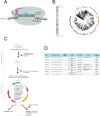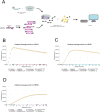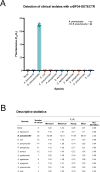Highly specific and sensitive detection of Burkholderia pseudomallei genomic DNA by CRISPR-Cas12a
- PMID: 36037185
- PMCID: PMC9423629
- DOI: 10.1371/journal.pntd.0010659
Highly specific and sensitive detection of Burkholderia pseudomallei genomic DNA by CRISPR-Cas12a
Abstract
Detection of Burkholderia pseudomallei, a causative bacterium for melioidosis, remains a challenging undertaking due to long assay time, laboratory requirements, and the lack of specificity and sensitivity of many current assays. In this study, we are presenting a novel method that circumvents those issues by utilizing CRISPR-Cas12a coupled with isothermal amplification to identify B. pseudomallei DNA from clinical isolates. Through in silico search for conserved CRISPR-Cas12a target sites, we engineered the CRISPR-Cas12a to contain a highly specific spacer to B. pseudomallei, named crBP34. The crBP34-based detection assay can detect as few as 40 copies of B. pseudomallei genomic DNA while discriminating against other tested common pathogens. When coupled with a lateral flow dipstick, the assay readout can be simply performed without the loss of sensitivity and does not require expensive equipment. This crBP34-based detection assay provides high sensitivity, specificity and simple detection method for B. pseudomallei DNA. Direct use of this assay on clinical samples may require further optimization as these samples are complexed with high level of human DNA.
Conflict of interest statement
The authors have declared that no competing interests exist.
Figures




References
Publication types
MeSH terms
Substances
Grants and funding
LinkOut - more resources
Full Text Sources
Other Literature Sources
Research Materials

